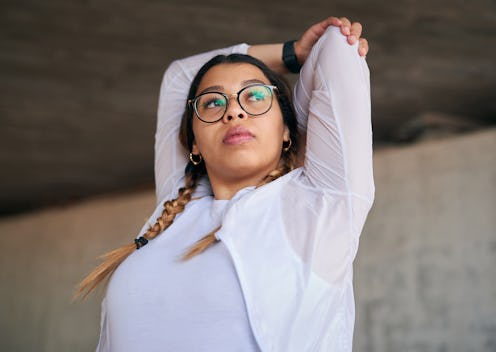Fitness
Does Stretching Help With Soreness?
The answer is complicated.

A good stretch has always been the go-to prescription for sore muscles. But do forward folds and bicep stretches actually do anything? To find an answer to this surprisingly complex question, it helps to know why soreness occurs in the first place.
When you work out, or place any sort of strain on your muscles, it causes little micro tears in the tissue, says Austin Martinez, MS, CSCS, ATC, a certified strength and conditioning specialist and director of education for StretchLab. “The sensation of soreness comes from these ‘micro tears’ and the subsequent inflammatory process,” he tells Bustle, as well as a build-up of lactic acid and other byproducts in the muscle.
While soreness sets in at different times for different people, you’ll probably feel it within a couple of hours after your workout, says TJ Mentus, an ACE-certified personal trainer. There is, however, a more severe form of muscle soreness called delayed onset muscle soreness, or DOMS, which could show up a few days later. “The longer it takes for DOMS to set in the worse it ends up being,” Mentus explains. “Typical soreness you can work through without much issues, but DOMS can limit range of motion significantly and be felt no matter how low intensity the movement is.”
When you’re hurting, it’s only natural to want to stretch things out. “It’s usually the first thing people want to do as it can provide immediate relief to the affected area,” Mentus says. But there’s definitely more the story. Here’s what you need to know about soreness, and whether or not stretching will help relieve your aches and pains.
Does Stretching Help With Soreness?
One thing stretching can do is open up the muscle fibers to allow more blood and oxygen to flow into the tissue, Mentus says. The extra blood flow then helps remove waste products from the muscle — like lactic acid and carbon dioxide — and accelerates the recovery process.
“When the body becomes fatigued, this is when the body is accumulating carbon dioxide faster than it can remove it,” Mentus says. “Keeping blood flow to the muscles post-workout will help to continue to clear out the left over carbon dioxide remaining.” This is often referred to as “flushing out” your muscles.
All of that said, stretching isn’t a magical remedy. Complete muscle recovery can take up to seven days, whether you stretch or not. And it’s also possible you won’t even want to do a deep stretch, Mentus says. And this is especially true if you have DOMS. There currently isn’t a proven or effective way to treat it, apart from attempting to speed up the healing process with a stretch, and finding ways to feel slightly more comfortable while you wait.
Stretches To Try
To nip soreness in the bud, remember to do a few stretches right after you work out. “This will help flush out the muscles and begin the recovery process,” Mentus says. While a post-workout stretch isn’t guaranteed to prevent soreness, it’s still beneficial and might limit the discomfort you feel from sore muscles.
1. Chest Stretch
Stand in a doorway and place your forearm against the doorframe with your elbow bent at 90 degrees. Gently push your chest forward so that you feel a stretch in the front of your shoulder. Repeat on the other side.
2. Runner’s Lunge
Start on your hands and knees. Extend one leg behind you with the knee on the ground. Bring your other foot forward next to your hand on that side. Gently push your hips forward towards the ground so that you feel a stretch in the front of the thigh.
3. Standing Forward Fold
Another option is to hinge forward at the waist with a slight bend in your knees. You should feel a stretch down your hamstrings and calves. Let your head hang as you reach to the ground to stretch your arms and back, too.
Other Ways To Relieve Sore Muscles
If you stretched and still feel sore, Mentus recommends getting active by going for a walk or taking an easy bike ride to further flush out your muscles. This is something you can do directly after your main workout, or on the days when you’re sore.
It might feel good to glide through a yoga flow for a dynamic stretch, too. “This allows the muscles to move through full ranges of motion while contracting,” he says, “which will improve mobility better than static stretching where the muscles are opened up but not necessarily working to control the movement.”
Rachel Warren, the founding instructor and VP of instructor operations, training, and development at FORWARD__Space, says it may also be beneficial to give yourself a massage, try foam rolling, or apply heat or ice packs — treatments that can help release muscle knots, bring more blood flow to the area, and reduce inflammation. “Turmeric is also a powerful remedy for muscle soreness,” Warren tells Bustle. “And water! Always hydrate when you’re sore.”
Studies referenced:
Cleary, M. A. 2006. Dehydration and symptoms of delayed-onset muscle soreness in normothermic men. Journal of athletic training, 41(1), 36–45.
Herbert, RD. 2011. Stretching to prevent or reduce muscle soreness after exercise. Cochrane Database Syst Rev. doi: 10.1002/14651858.CD004577.
MacIntyre, DL. 1995. Delayed muscle soreness. The inflammatory response to muscle injury and its clinical implications. Sports Med. doi: 10.2165/00007256-199520010-00003.
Mallard, AR. 2021. Curcumin Improves Delayed Onset Muscle Soreness and Postexercise Lactate Accumulation. J Diet Suppl. doi: 10.1080/19390211.2020.1796885.
Sources:
Austin Martinez, MS, CSCS, ATC, certified strength and conditioning specialist and director of education for StretchLab
TJ Mentus, ACE-certified personal trainer with Garage Gym Reviews
Rachel Warren, founding instructor and VP of instructor operations, training, and development at FORWARD__Space
This article was originally published on